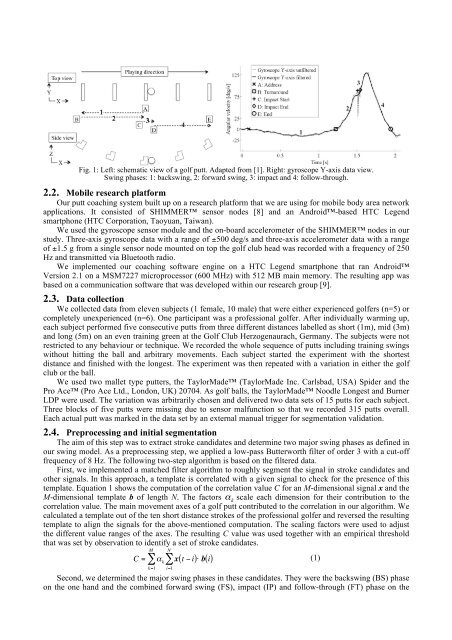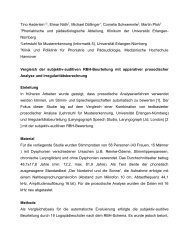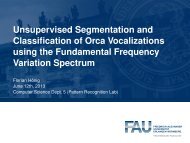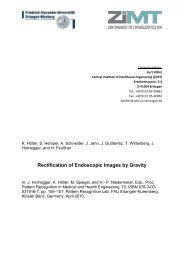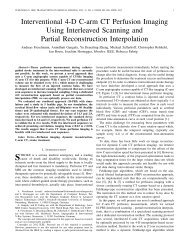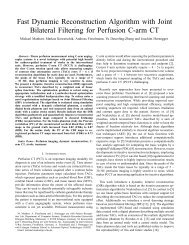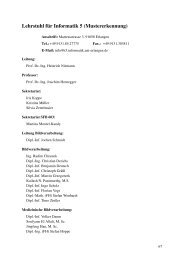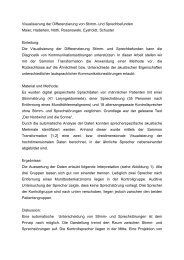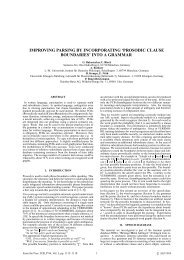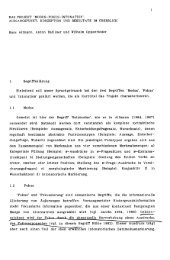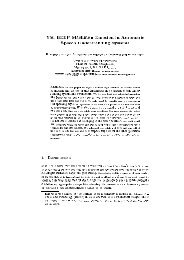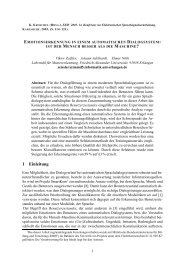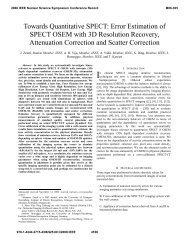You also want an ePaper? Increase the reach of your titles
YUMPU automatically turns print PDFs into web optimized ePapers that Google loves.
Fig. 1: Left: schematic view of a golf putt. Adapted from [1]. Right: gyroscope Y-axis data view.<br />
Swing phases: 1: backswing, 2: forward swing, 3: impact and 4: follow-through.<br />
2.2. Mobile research platform<br />
Our putt coaching system built up on a research platform that we are using for mobile body area network<br />
applications. It consisted of SHIMMER sensor nodes [8] and an Android-<strong>based</strong> HTC Legend<br />
smartphone (HTC Corporation, Taoyuan, Taiwan).<br />
We used the gyroscope sensor module and the on-board accelerometer of the SHIMMER nodes in our<br />
study. Three-axis gyroscope data with a range of ±500 deg/s and three-axis accelerometer data with a range<br />
of ±1.5 g from a single sensor node mounted on top the golf club head was recorded with a frequency of 250<br />
Hz and transmitted via Bluetooth radio.<br />
We implemented our coaching software engine on a HTC Legend smartphone that ran Android<br />
Version 2.1 on a MSM7227 microprocessor (600 MHz) with 512 MB main memory. The resulting app was<br />
<strong>based</strong> on a communication software that was developed within our research group [9].<br />
2.3. Data collection<br />
We collected data from eleven subjects (1 female, 10 male) that were either experienced golfers (n=5) or<br />
completely unexperienced (n=6). One participant was a professional golfer. After individually warming up,<br />
each subject performed five consecutive putts from three different distances labelled as short (1m), mid (3m)<br />
and long (5m) on an even training green at the <strong>Golf</strong> Club Herzogenaurach, Germany. The subjects were not<br />
restricted to any behaviour or technique. We recorded the whole sequence of putts including training swings<br />
without hitting the ball and arbitrary movements. Each subject started the experiment with the shortest<br />
distance and finished with the longest. The experiment was then repeated with a variation in either the golf<br />
club or the ball.<br />
We used two mallet type putters, the TaylorMade (TaylorMade Inc. Carlsbad, USA) Spider and the<br />
Pro Ace (Pro Ace Ltd., London, UK) 20704. As golf balls, the TaylorMade Noodle Longest and Burner<br />
LDP were used. The variation was arbitrarily chosen and delivered two data sets of 15 putts for each subject.<br />
Three blocks of five putts were missing due to sensor malfunction so that we recorded 315 putts overall.<br />
Each actual putt was marked in the data set by an external manual trigger for segmentation validation.<br />
2.4. Preprocessing and initial segmentation<br />
The aim of this step was to extract stroke candidates and determine two major swing phases as defined in<br />
our swing model. As a preprocessing step, we applied a low-pass Butterworth filter of order 3 with a cut-off<br />
frequency of 8 Hz. The following two-step algorithm is <strong>based</strong> on the filtered data.<br />
First, we implemented a matched filter algorithm to roughly segment the signal in stroke candidates and<br />
other signals. In this approach, a template is correlated with a given signal to check for the presence of this<br />
template. Equation 1 shows the computation of the correlation value C for an M-dimensional signal x and the<br />
M-dimensional template b of length N. The factors α k<br />
scale each dimension for their contribution to the<br />
correlation value. The main movement axes of a golf putt contributed to the correlation in our algorithm. We<br />
calculated a template out of the ten short distance strokes of the professional golfer and reversed the resulting<br />
template to align the signals for the above-mentioned computation. The scaling factors were used to adjust<br />
the different value ranges of the axes. The € resulting C value was used together with an empirical threshold<br />
that was set by observation to identify a set of stroke candidates.<br />
€<br />
C =<br />
M N<br />
∑α k<br />
k =1 i=1<br />
∑ x( t − i)⋅ b( i)<br />
(1)<br />
Second, we determined the major swing phases in these candidates. They were the backswing (BS) phase<br />
on the one hand and the combined forward swing (FS), impact (IP) and follow-through (FT) phase on the


